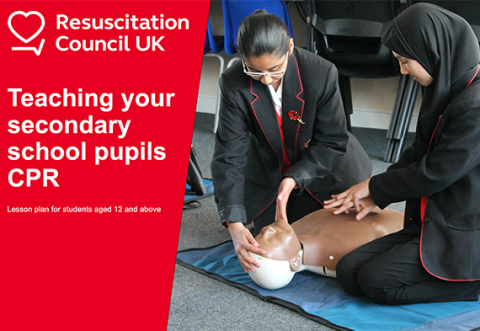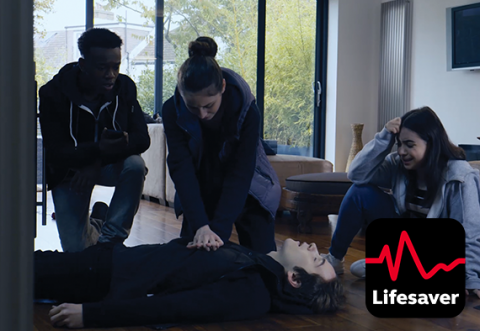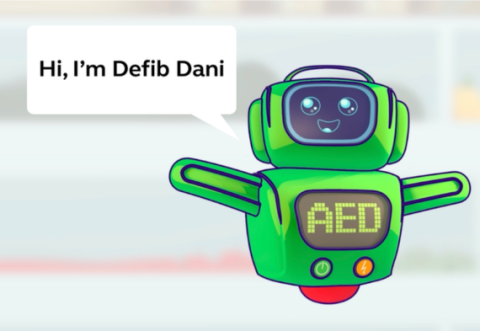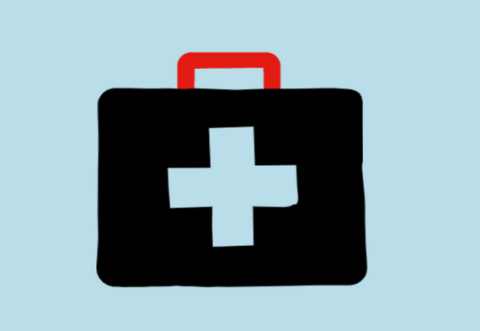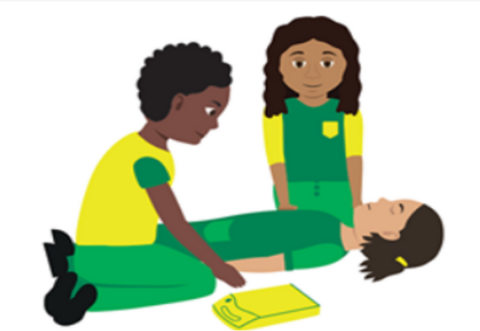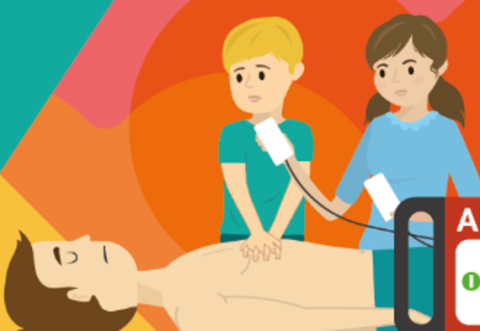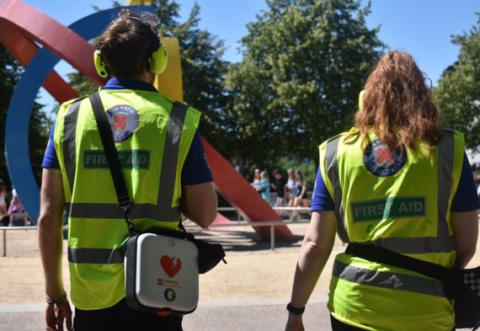

Resuscitation Council UK is the kitemark organisation for resuscitation in the UK. We have created resources that will help teachers to deliver CPR education confidently to their students wherever they live in the UK at any time during the school year. If you’re looking for a suitable moment, Restart a Heart month takes place every year in October.
At RCUK, we believe that everyone should learn the skills to save a life. Schools offer a great environment for young people to learn and we have created a lesson plan to help you teach your students with confidence.
Skills in cardiopulmonary resuscitation (CPR) and the use of an automated external defibrillator (AED) are skills for life - and educating and empowering young people is one of the most important actions when it comes to improving survival of out of hospital cardiac arrests.
In countries where basic life support is taught in schools, survival rates from sudden cardiac arrest are significantly (two to three times) higher than those where they aren’t taught. With 80% of cardiac arrests occurring in the home in the UK, your students could be the difference between life and death for someone they care about.
Check out the commitements that governments and local authorities have made across the UK to ensure CPR is taught in schools:
In England, teaching cardiopulmonary resuscitation (CPR) is part of the Health Education curriculum for secondary school students and is recommended for students aged 12+. It states that pupils should know life-saving skills, including how to administer CPR and the purpose of defibrillators and when one might be needed. Millions of children in England now have access to life-saving defibrillators in every state school in England. The Government has ensured every state school in England has a lifesaving defibrillator. 20,376 defibrillators have been delivered to 17,862 state-funded schools.
Every local authority in Scotland has committed to teach CPR to their secondary school pupils.
In 2021, the Curriculum and Assessment (Wales) Bill passed into law. The Welsh Government agreed to include lifesaving skills in the statutory guidance as part of this process. This means CPR has been taught in Welsh schools since 2022.
At key stages 3 and 4 for the Northern Ireland Curriculum the links with the concept of personal health are strong: “develop preventative strategies in relation to accidents in the home, school and on the road, for example knowing what to do in the event of cuts, burns, fire and emergency first aid etc.” From the 2022/23 academic year all pupils in Northern Ireland aged 11-14 should be provided with CPR training as part of the school curriculum.
The government is also supporting schools in making defibrillators available to the community, with 1,200 external heated defibrillator cabinets being provided to primary and special schools by the end of 2023 in areas of deprivation, where provision is generally lower.
Department for Education’s guideline recommends positioning defibrillators in publicly accessible areas. This rollout will build on existing requirements for schools to teach first aid as part of the curriculum, with secondary school pupils being taught life-saving methods such as CPR and the purpose of defibrillators.
Nearly 4 in 10 students (38%) say they haven’t received CPR training in school.
Although governments and local authorities across the UK introduced policies since 2019 to ensure CPR is taught in secondary schools, there is currently no structured way to track whether this training is being delivered. Without proper monitoring and support, too many students are leaving school without learning how to save a life. On Thursday 10 April 2025, RCUK launched a petition to ensure that every student leaves school with the skills to help save a life.
We are calling for governments, education providers, inspectorates, and communities to work together to embed CPR training within existing school inspection frameworks. This will enable CPR training to become a standard component of school evaluations, ensuring consistent delivery. Sign the petition today.
Here’s how you can give pupils the skills to try to save a life if they witness someone collapse and stop breathing normally:
RCUK CPR Lesson Plan for Secondary School Pupils
A lesson plan for teachers which covers in person and online options for how to teach crucial skills.
Lifesaver
A free digital game-in-a-film which puts young people at the heart of the action as they make the decisions and learn the skills needed to save a life.
Video: Sam's story
A real-life story of why CPR knowledge in the classroom was the difference between life and death for secondary student Sam.
Defib Dani Animation
A short animation featuring cartoon character Defib Dani, who walks you through the simple steps to using a defibrillator, giving people the confidence to use a defibrillator during a cardiac arrest.
Template letters
We have also created template letters you can send to students’ parents / guardians in advance of you teaching this sensitive subject. All you need to do is tailor the template for the lesson option you will be using.
A Basic Life Support Skills Checklist can also be used to support evaluation of student learning.
CPR Teacher Training resources from key partners:
As the kitemark organisation in resuscitation, and the standard-setter in CPR teacher training, RCUK works with key partners to ensure that teachers can give pupils the skills they need to save a life.
We have partnered with British Heart Foundation, St Andrews First Aid, St John Ambulance, British Red Cross, the East London Cardiovascular Prevention (ELoPe-CVD) group from Barts Health NHS Trust, and others, to develop a webpage that promotes key cardiopulmonary resuscitation (CPR) teacher training resources.
Please find below a list of the key partners who offer CPR and First Aid Teaching training resources:
Teach CPR in your school for free with Classroom RevivR
Classroom RevivR is the British Heart Foundation’s free, interactive tool to help students learn lifesaving skills in CPR and defibrillation in the classroom. The digital tool makes it easy and stress-free for schools to meet curriculum objectives, and there’s no need for external trainers or specialist equipment. Classroom RevivR is free to all educational settings which teach 11-16 year olds.
British Red Cross First Aid Champions
British Red Cross First Aid Champions will help you confidently deliver first aid learning sessions at your school or youth group. Through easy-to-follow activities and a variety of engaging and impactful supporting materials, the resources are simple to teach and easy to learn.
St John Ambulance First Aid Lesson Plan Resources
St John Ambulance Key Stage 3 and 4 lesson plans and teaching resources have been developed to support teaching first aid as part of health education for secondary school pupils. These outline a recommended order for teaching the different first aid topics including CPR and AED awareness to your students.
Community of Lifesavers Education Programme
CCEA has partnered with the Northern Ireland Ambulance Service (NIAS), the Department of Education (DE) and the Education Authority to create the Community of Lifesavers Education Programme. This Hub provides a range of resources to support schools in the effective delivery of Community of Lifesavers Educations Programme (COLEP) and other emergency first aid procedures at Key Stage 3.
St Andrew's First Aid Community Engagement
St Andrew's First Aid Community Engagement Facilitator volunteers deliver free first aid sessions in schools, charities, and community groups across Scotland on a wide range of first topics from CPR and how to use a defibrillator, to bandaging a wound and treating heat exhaustion. In 2023 the volunteers demonstrated how to perform CPR and use a defibrillator to over 12,000 people in Scotland.
St Andrew's First Aid Scottish Primary School First Aid Programme
Whilst this resource hub is focused on secondary schools, we’ve included this valuable programme for primary educators. Introducing CPR at an early age lays a strong foundation that can be built upon in secondary school. This teaching guide supports Scottish Primary School teachers in delivering age-appropriate, engaging, and practical lessons that build essential first aid and CPR awareness.
These frequently asked questions have been developed to help teachers answer questions you may be asked by students when teaching CPR. We recommend you have these to hand during the lesson.
CPR stands for cardiopulmonary resuscitation. It is a term that encompasses the different techniques used to resuscitate a person after a sudden cardiac arrest.
There are two important skills to know when doing CPR for both adults and children:
Chest compressions: this is where you place the heel of one hand in the centre of the collapsed person’s chest, place the heel of your other hand on top of the first hand, interlock the fingers of your hands and push hard and fast on the chest to help pump blood around the person’s body. You should keep a steady rhythm of about 100-120 compressions every minute. Try humming ‘Baby Shark’ or ‘Stayin’ Alive’ to help you keep to the beat.
Rescue breaths: also known as ‘mouth-to-mouth’, these give the person oxygen that could help them breathe again.
Resuscitation Council UK recommends that during times of increased infection, e.g. the COVID-19 pandemic, people should carry out chest compressions only.
A cardiac arrest is when the heart has stopped pumping blood around the body and the person has become unresponsive. This may occur for many reasons, but loss of the electrical coordination that controls the normal heartbeat is usually responsible.
The most likely cause is ventricular fibrillation, in which the normal orderly electrical signal that controls the heartbeat becomes completely disorganised and chaotic, and the heart is unable to act as a pump.
No, the terms mean different things. Although ‘heart attack’ is often used to refer to a sudden cardiac arrest, this is incorrect.
A heart attack (or myocardial infarction, to use the medical term) occurs when an artery supplying the heart with blood becomes blocked. During a heart attack the heart is still pumping, the person will remain responsive and have symptoms like chest pain and feel nauseated or sick.
A heart attack may cause cardiac arrest, particularly in the early stages, but this is not inevitable.
Because of this, the emphasis is on calling for immediate help to reduce the damage to their heart and reduce the risk of a cardiac arrest occurring.
The Chain of Survival describes a sequence of steps that together maximise the chance of survival following cardiac arrest.

Figure 1: Chain of Survival
The first link in the chain is the immediate recognition of cardiac arrest and calling for help.
The second is the prompt initiation of CPR.
The third is performing defibrillation as soon as possible.
The fourth is optimal post resuscitation care in hospital, which begins with your explanation to the paramedics, when they arrive, of what has happened and your actions.
Like any chain, it is only as strong as its weakest link. If one stage is weak, the chances of successful resuscitation are compromised. Early intervention in the first three stages is where a witness can make the biggest difference and increase the collapsed person’s chances of survival by 2-3 times.
If bystanders who witness a cardiac arrest perform CPR, enough blood containing oxygen will reach the brain, heart and other vital organs to keep the person alive for several minutes. CPR by itself will not restart the heart, but it ‘buys time’ for the emergency medical services to reach the scene. Effective CPR more than doubles the chance of someone surviving a cardiac arrest.
In the UK fewer than 10% of all the people in whom a resuscitation attempt is made outside hospital survive. Improving this figure is a major priority for Resuscitation Council UK, the Department of Health and Social Care, ambulance services and first aid organisations.
When all the stages in the Chain of Survival take place promptly, the figures are very much better. This is possible where the cardiac arrest is recognised immediately, bystanders perform CPR, and an automated defibrillator is used before the ambulance service arrive. Survival rates in excess of 50% have been reported under these circumstances.
Compression-only CPR describes the performance of uninterrupted chest compressions without rescue breaths. In many adults who suffer a cardiac arrest, the heart stops abruptly; breathing will have been normal (or nearly normal), so the blood should be well oxygenated. In this situation compression-only CPR may be effective for the first few minutes after the heart stops. This may provide time for the emergency services to arrive or an AED to be collected.
Resuscitation Council UK recommends bystanders carry out compression-only CPR currently due to the potential increased risk of infection due to COVID-19.
When the heart stops, blood supply to the brain also stops. The person will collapse, lose consciousness and will be unresponsive. The person will not be breathing normally, although it may take a few minutes to stop completely. For the first few minutes the person who has collapsed may take noisy, infrequent or gasping breaths.
If you have any doubt whether someone is breathing normally or not, assume it is NOT normal: call 999 immediately and start CPR.
An Automated External Defibrillator (AED) is a machine that analyses the electrical rhythm of the heart and delivers an electric charge/shock when an abnormal rhythm is detected.
The reason this is important is because a sudden cardiac arrest (SCA) usually occurs when the normal electrical rhythm that controls the heart is replaced by a chaotic disorganised electrical rhythm called ventricular fibrillation.
AEDs are compact, portable, easy to use and guide the operator through the process with prompts and commands. An AED precisely analyses the heart rhythm of the person who is unresponsive and will only deliver a shock if it is required. The sooner the heart is restarted, the better the casualty’s chance of survival.
It can take 8 to 10 minutes for an ambulance to arrive so using a defibrillator could save a life.
AEDs are very reliable and will not allow a shock to be given unless it is needed. They are extremely unlikely to do any harm to a person who has collapsed in suspected sudden cardiac arrest. They are safe to use and present minimal risk to the rescuer. These features make them suitable for use by members of the public with little or no training.
Public Access Defibrillation describes the use of AEDs by members of the public. AEDs can now be found in many busy public places including airports, mainline railway stations, shopping centres, and gyms. They are meant to be used by members of the public if they witness a cardiac arrest.
When you call the ambulance service you will be directed to the nearest registered device. Staff working at the location should also know the location of an AED nearby.
In some places defibrillators are kept in a cabinet. If a cabinet is locked the emergency services operator will give you a code over the phone that you can use to unlock it.
People can still help even if they cannot do CPR themselves (e.g. they are not strong or confident enough).
They can:
- recognise an emergency, call 999 and look out for the ambulance
- call out for someone else to help give CPR
- help someone else to perform CPR:
- talk them through the steps
- count chest compressions
- provide ‘moral support’ and reassurance that they are doing the right things
It is very unlikely that someone in the UK who acted in good faith when trying to help another person would be held legally liable for an adverse outcome. No such action has ever been brought against someone who performed CPR and, in general, the courts in the UK look favourably on those who go to the assistance of others.
Resuscitation Council UK has published detailed guidance on the legal status of those who attempt resuscitation. This provides answers to most of the commonly asked questions on the subject.
In an emergency, it's usually in a person's best interests to commence resuscitation.
If you are aware that the person has an up to date 'Do Not Attempt Cardiopulmonary Resuscitation' (DNACPR) recommendation, or Advanced Decision to Refuse Treatment in place, or has had a documented ReSPECT (Recommended Summary Plan for Emergency Care and Treatment) conversation with a health care professionals, call the emergency services and they can advise what to do.
For more FAQs visit our online support system
If you have any further questions or feedback, please let us know by filling in the form below.
